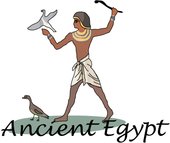Pharaoh
|
|
Pharaoh is a title used to refer to the kings (of godly status) in ancient Egypt.
The term derives ultimately from the Egyptian words Pr-Aa meaning "Great House". Originally a term for the royal palace, this word came into vogue to refer to the king. The earliest certain instance of the term "pharaoh" is in a letter addressed to Thutmose III in the mid-Eighteenth Dynasty (1539-1292 BC). By the Twenty-second Dynasty (c. 945-c. 730 BC) this usage had been extended and was now used occasionally just as hm.f "His Majesty" was used in earlier periods. It was not the official title but was used in letters to the monarch. It is frequently used by modern historians due to its use in the Bible, especially the Book of Exodus, and in the Ancient Greek and Roman writers; although the Bible, at least in the Hebrew original, treats Pharaoh like a proper name rather than like a title.
| Contents |
Open problems
There are several open problems concerning ancient Egyptian pharaohs . It is unknown who was the first pharaoh of Egypt. It may have been the pharoahs Menes or Narmer (or they could be part of Egyptian mythology). If both were real, it is unknown who came first exactly. Scholars have wondered if Ramesses II defended Egypt against the Sea People because they were invading or were they people fleeing to Egypt in the middle of a war. It is questioned that Ramesses III or Amenemhat I were asassinated.
The exact circumstances surrounding the dissapearance of Akhenaten's wife, Nefertiti, is unknown. The body of Akhenaten himself has not been found, and it is unknown if Akhenaten was killed or exiled. The exact nature of what Akhenaten believed is also still debated by scholars. The parentage of the next pharaoh after Akhenaten, Tutankamun, is uncertain, and it is not even known, for certain, when Tutankhamun died, or what the nature of his death was. The alleged curse of Tutankhamun's tomb is questioned by many.
What happened to Hatshepsut is unknown and Hatshepsut's relationships with Senenmut is debated. It is clear that Cleopatra was a Greek not an Egyptian. Controversy exists if Cleopatra was pretty but is is clear that she was not black. The kind of reign Pharaoh Smendes I's rule was is debated by scholars. It is questioned if Egypt split during his governance. It is unclear if Khababash of the Thirtieth dynasty of Egypt was a proper Pharaoh and from where Khababash came from. It is unknown if Necho II really sent out an expedition which sailed from the Red Sea around Africa back to the mouth of the Nile.
There are a questions concerning the practices among egyptians regarding their pharaohs. It is question if the Pharaoh was really seen as a god or if the postion he held was just viewed as divine. It is not known for certain if the pharaohs married their sisters.
Regalia and titles
The king of Egypt wore a double crown, created from the Red Crown of Lower Egypt and the White Crown of Upper Egypt. It was adorned by a uraeus, which was doubled under the Twenty-fifth Dynasty. The official titulary of the king by the New Kingdom consisted of five names; for some rulers, we know only one or two of them. In the order of their appearance they are:
- The Horus Name. This is the earliest recorded name, which was created to identify the king with an aspect of the Hawk-god Horus. It was written inside a serekh.
- The nebty (meaning (female) two) Name. This name was associated with the goddess of Upper Egypt (the vulture-goddess Nekhbet), and the goddess of Lower Egypt (the cobra-goddess Wadjet).
- The Golden Falcon Name. This name first appeared in the Twelfth Dynasty, and became a part of the official titulary.
- The Praenomen. The throne name, by which he was addressed in diplomatic correspondence. It was the first of the two names written inside a cartouche, and usually accompanied by one of two phrases: either n-sw-bity, "He of the Sedge and the Bee"; or neb tawy, "Lord of the Two Lands".
- The Nomen. This was given to the crown prince at birth; it was his "real" name. The other names were received at his coronation. Beginning with Chephren of the Fourth Dynasty, this name was introduced by the title "son of Ra."
Related entries
See also
Ancient Egypt Clipart and Pictures
- Ancient Egypt Architecture (http://classroomclipart.com/cgi-bin/kids/imageFolio.cgi?direct=History/Ancient_Civilizations/Ancient_Egypt/Architecture)
- Ancient Egypt Art (http://classroomclipart.com/cgi-bin/kids/imageFolio.cgi?direct=History/Ancient_Civilizations/Ancient_Egypt/Art)
- Ancient Egypt Clipart (http://classroomclipart.com/cgi-bin/kids/imageFolio.cgi?direct=History/Ancient_Civilizations/Ancient_Egypt/Clipart)
- Ancient Egypt Clothing (http://classroomclipart.com/cgi-bin/kids/imageFolio.cgi?direct=History/Ancient_Civilizations/Ancient_Egypt/Clothing)
- Ancient Egypt Architecture (http://classroomclipart.com/cgi-bin/kids/imageFolio.cgi?direct=History/Ancient_Civilizations/Ancient_Egypt/Commerce)
- Ancient Egypt Daily Life (http://classroomclipart.com/cgi-bin/kids/imageFolio.cgi?direct=History/Ancient_Civilizations/Ancient_Egypt/Daily_Life)
- Ancient Egypt Games and Toys (http://classroomclipart.com/cgi-bin/kids/imageFolio.cgi?direct=History/Ancient_Civilizations/Ancient_Egypt/Games_and_Toys)
- Ancient Egypt Hieroglyphs (http://classroomclipart.com/cgi-bin/kids/imageFolio.cgi?direct=History/Ancient_Civilizations/Ancient_Egypt/Hieroglyphs)
- Ancient Egypt People (http://classroomclipart.com/cgi-bin/kids/imageFolio.cgi?direct=History/Ancient_Civilizations/Ancient_Egypt/Historical_People)
- Ancient Egypt Illustrations (http://classroomclipart.com/cgi-bin/kids/imageFolio.cgi?direct=History/Ancient_Civilizations/Ancient_Egypt/Illustrations)
- Ancient Egypt Mummies (http://classroomclipart.com/cgi-bin/kids/imageFolio.cgi?direct=History/Ancient_Civilizations/Ancient_Egypt/Mummies)
- Ancient Egypt Musical Instruments (http://classroomclipart.com/cgi-bin/kids/imageFolio.cgi?direct=History/Ancient_Civilizations/Ancient_Egypt/Musical_Instruments)
- Ancient Egypt Pyramids (http://classroomclipart.com/cgi-bin/kids/imageFolio.cgi?direct=History/Ancient_Civilizations/Ancient_Egypt/Pyramids)
- Ancient Egypt Religion (http://classroomclipart.com/cgi-bin/kids/imageFolio.cgi?direct=History/Ancient_Civilizations/Ancient_Egypt/Religion)
- Ancient Egypt Statues (http://classroomclipart.com/cgi-bin/kids/imageFolio.cgi?direct=History/Ancient_Civilizations/Ancient_Egypt/Statues)
- Ancient Egypt Temples (http://classroomclipart.com/cgi-bin/kids/imageFolio.cgi?direct=History/Ancient_Civilizations/Ancient_Egypt/Temples)
- Ancient Egypt Transportation (http://classroomclipart.com/cgi-bin/kids/imageFolio.cgi?direct=History/Ancient_Civilizations/Ancient_Egypt/Transportation)
- Ancient War and Armies (http://classroomclipart.com/cgi-bin/kids/imageFolio.cgi?direct=History/Ancient_Civilizations/Ancient_Egypt/War_and_Armies)
External links
- Tutankhamun: Pictures (http://www.insecula.com/contact/A001726.html/)
- Egyptian Royal Genealogy (http://www.tyndale.cam.ac.uk/Egypt/index.htm)
- Digital Egypt for Universities (http://www.digitalegypt.ucl.ac.uk/Welcome.html)

